An implant is a fixed dental solution designed to replace one or more missing or decaying teeth. There are three parts to an implant, the fixture, a small titanium screw that is inserted into the jawbone, below the gum line, that acts as an artificial tooth root anchoring your new tooth replacement. The middle part is called the abutment, which is the part that connects the fixture to the new crown. And lastly the crown, being your new artificial tooth. An implant is the ideal solution if you’ve lost or are losing one or more of your natural teeth.
Tooth loss is a common problem that many people face for different reasons. It can be from tooth decay, a random sporting accident, case of severe gum disease or a potentially failed root canal procedure. If left untreated, a gap in your smile can not only look unattractive, but it can also lead to other oral health problems. The teeth beside the ‘gap’ will often shift or tilt into the vacant gap space. This can lead to instability in your other neighbouring teeth which can then cause your bite to misalign leading to difficulty eating. To compound the problem, over time, the bone where the root of the missing tooth used to be, starts to shrink away making the gap worse. The loss of a single tooth may seem like a small thing, but it can have dramatic effect on your oral health and can be fixed with a single tooth implant.
The single tooth implant looks, feels and functions very similar to a natural tooth. It mimics the contours, shape and form of natural teeth and is fixed in your mouth. This means that you cannot remove it once fitted, but we can!


The single tooth implant is the preferred long-term treatment option to replace a tooth over other alternatives like traditional removable dentures or tooth-supported bridges. With the aim to deliver high quality, natural tooth aesthetics to our patients, the single tooth implant solution offers the most natural looking, feeling and functioning result.
Implant bridges are used to replace multiple missing teeth. Unlike conventional bridges, which require significant tooth removal and crowns to anchor the prosthesis, implant bridges are held in place by the implants which have been inserted into the jawbone, without compromising any existing healthy teeth.


A full arch implant bridge, is a fixed dental prosthesis designed to replace your entire upper or lower row of missing, broken or decaying teeth. This prosthesis is usually attached to between 4 and 6 implants. A full arch bridge mimics the contours, shape and form of natural teeth. A fixed full arch prosthesis allows you to replace your missing teeth without needing to cover the roof of your mouth. This is beneficial for those who have a strong “gag” reflex and cannot tolerate wearing a full denture. Once a fixed bridge is secured to the implants, it can only be removed by a dental professional. Regular maintenance and cleaning are required to ensure optimal implant health, soft tissue health and integrity of the bridge.
There are two main options for a full arch fixed prosthesis.
1. Hybrid Design / Fixed Denture
Suitable for those who are not only missing teeth but also reduced bone and soft tissue.

2. Full Arch Fixed Implant Bridge
Suitable for those who still have enough bone and soft tissue for ideal profile, but have missing/compromised dentition.

Like a conventional full denture, an implant retained denture allows you to replace all your teeth however it is stabilised by having it clip into the implants. Implant retained dentures are particularly popular in the lower jaw, as full lower dentures are uncomfortable and generally move around while eating and laughing. Traditionally 2 or more implants are inserted into the jawbone and once healed either your existing denture or a new denture is designed to clip into the implants creating a secure platform to allow you to function normally again.
A clear and informative discussion with Dr Michael Lamantia about your individual treatment needs and concerns. Diagnostic records are required to accurately create your implant treatment plan. This involves taking impressions (moulds of your teeth), intra-oral and extra-oral x-rays, CBCT scan (3D x-ray) and we may take numerous clinical photographs. These records are essential for the planning phase and to determine the most appropriate treatment plan for you.
A dental implant (titanium screw) is placed into the jawbone. The surgery is completed with any necessary bone and tissue grafting repair. Depending on the case, either a cover screw is placed on the implant and buried under the gum to heal for 3 months, this process requires a second surgical appointment after 3 months to expose the implant and then place the healing abutment. Alternatively, a healing abutment is placed on the implant which allows the gum to heal around it and creates the ideal emergence for the final crown fabrication.
After a period of healing (approx. 3 months) you will return for an impression of the implant for construction of the final crown. The final crown is made by an accredited lab in Australia with genuine componentry. Once the crown is ready, the healing abutment is removed, and the final crown is screwed into the implant. You are now ready to use your new tooth!
All images on this page courtesy of Neoss Dental Implants
Riverwalk Centre
144 River St
Ballina
NSW 2478
Monday-Friday 8:30am-5:00pm